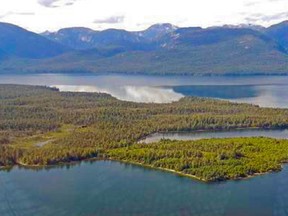
In an open letter published on May 25, Pat Moss, a coordinator for the environmental group Friends of Wild Salmon and a signatory of the letter, wrote that a lack of details on upcoming federal and provincial emission caps made it difficult to accurately determine how the $10-billion, Nisga’a-led Ksi Lisims LNG project would impact emissions targets.
They asked the province to “significantly” extend the current public comment period, which ran from April 27 to May 29, or to postpone environmental assessment until more information on federal and provincial emissions caps was available.
“A public comment period should not be conducted when it is unclear how forthcoming legislation and regulations will impact what needs to be considered,” Moss wrote.
Matthew Borghese, a spokesperson for B.C.’s Environmental Assessment Office, said the office was not planning to extend the current public comment period.
“The environmental assessment process will include at least two additional public comment periods,” Borghese wrote. One that will include greenhouse gas assessments.
“The draft plan proposes that the proponent be required to prepare information that enables assessment of greenhouse gas emissions in relation to federal and provincial legislation,” Borghese wrote.
B.C.’s Environmental Assessment Act requires the office to take into account the impact of a project on the province’s greenhouse gas emissions during the environmental assessment process, which could take up to 18 months or more to complete.
An environmental analysis of the Ksi Lisims LNG export facility was green lit by the assessment office in mid-March, just days after the B.C. government gave final approval to the $2.4-billion Haisla Nation’s Cedar LNG project.
Nisga’a leadership say the Ksi Lisims project – located in northwest B.C. near the border of Alaska – will be “net-zero” emissions from Day 1, in part by tapping into B.C. Hydro’s electrical grid to power the facility as well as a carbon offset management program.
“We’re confident that the Ksi Lisims LNG project’s sustainable and innovative design will enable us to meet the government’s new standards,” said Rebecca Scott, a spokesperson for Ksi Lisims LNG.
Electrifying the facility would first mean the construction of 95 kilometres of power lines to the site. Much of that would cross the territory of First Nations who have expressed concerns about environmental and other impacts of the construction.

Without electrification, emissions would be up to 1.9 million tonnes of carbon dioxide equivalent per year — nearly three per cent of B.C.’s annual emissions and the equivalent of burning nearly a billion kilograms of coal every year.
And that only includes emissions from the facility itself.
When emissions generated by the fracking and transportation of LNG — so-called “upstream” emissions — are included, the figure more than doubles.
The Pembina Institute, a clean energy think-tank, estimated the Ksi Lisims project would generate the same emissions as burning 2.3 million tonnes of coal every year. That’s about the same as a million gas-powered cars each year.
The project is expected to operate for 30 years.
Young said LNG facilities are typically powered by natural gas, not electricity, and that would lead to an increase in the amount of gas that needs to be extracted from B.C.
“We’re talking about a significant expansion of fracking,” he said, that will contribute “to an increase in global greenhouse gas emissions.”
Young said that virtually all of the gas processed by the facility is intended to be sold overseas.
In a letter to the B.C. EAO dated March 7, Eva Clayton, president of the Nisga’s Lisims government, called the Ksi Lisims project a “generational opportunity” to achieve lasting reconciliation.
“The Nisga’a Nation is committed to building the project so that it is compliant with BC climate mitigation laws and policy,” Clayton wrote.
— with a file from Gord Hoekstra


